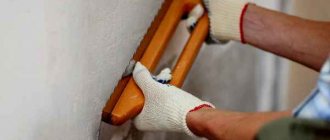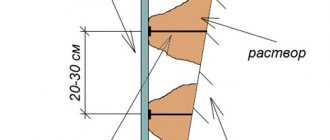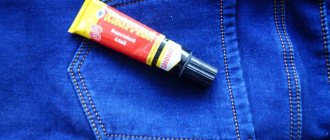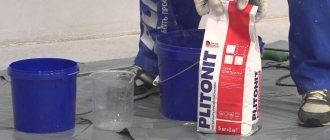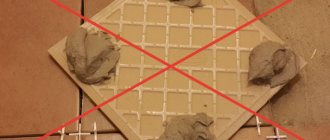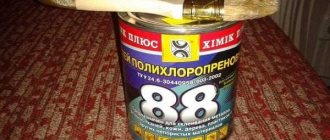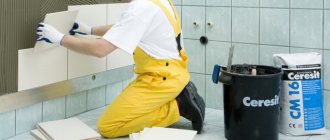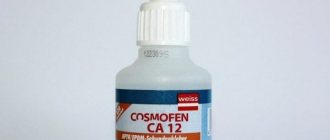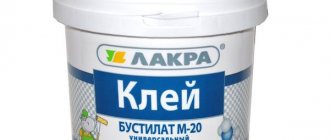The product is sold in a small tube, which is convenient not only to store in a medicine cabinet, but also to carry with you. Medical glue for cuts and wounds is used mainly in surgery and dentistry (dentists often use glue to protect the roots of teeth and gums from various infections), in the postoperative period. The film that forms on the wound prevents water from penetrating there, but allows oxygen to pass through. It is characterized by increased elasticity, which ensures seamless connection of wound edges and scarless healing.
The product stays on the wound for several days, which is very important, since you don’t have to disturb damaged and inflamed skin. Throughout this period, the product retains its anti-inflammatory properties. After complete drying, the film falls off on its own without damaging thin young skin. The drug does not cause additional irritation or pain (on the contrary, when applying glue to the root of the tooth, an analgesic effect occurs).
Medical glue is most often used for healing:
- scratches;
- abrasions;
- cuts;
- shallow wounds;
- cracks;
- painful calluses;
- burns.
Some women may be advised to use BF to heal mini-cuts that occur during a manicure or when removing hangnails. The drug is suitable for any damage to the skin, except for deep ones that require stitching.
Glue is a liquid, viscous solution of yellow or red color. It does not deteriorate or corrode, which is especially important in surgery.
The product contains substances such as:
- ethyl alcohol (main component);
- polyvinyl butyral;
- phenol-formaldehyde resin;
- dibutyl phthalate;
- rosin;
- Castor oil.
The drug is available in tubes of 10, 15, 25 and 30 g each.
Areas of application and characteristics of BF 6 glue
This brand of glue is a thick transparent or slightly cloudy mass of yellowish or yellowish-red color. The basis of BF-6 glue is ethyl alcohol, the composition also includes: polyvinyl butyral, phenol-formaldehyde resin, dibutyl phthalate, rosin and castor oil.
Medical glue BF-6
used topically for quick connection of living tissues, treatment of postoperative sutures and minor injuries - cuts, abrasions, cracks, deep scratches, painful calluses and other damage to the skin.
A layer of glue applied to a wound or burn forms a thin insulating film that protects the damaged area of skin from the penetration of bacteria and promotes rapid healing of the wound.
Very often, medical BF becomes an alternative to a conventional patch, since it forms a film that is very resistant to mechanical stress. Unlike adhesive plaster, the glue is removed from the wound painlessly.
Found a use for BF-6 glue
and in dentistry. During the surgical removal of granuloma nodules, cysts and other inflammatory processes, the composition is used to cover the tooth root in order to protect the root canal from pathogens and decay products of surrounding tissues. In this case, the glue has an antibacterial effect.
BF-6 glue is absolutely safe for external use and has virtually no contraindications. It is not recommended for use only by people with hypersensitivity to the components of the drug and children under one year of age. The maximum possible side effect is a burning sensation in the area of application and local allergic reactions (redness, slight itching, etc.).
Glue BF-6: instructions for use, price, application to wounds, burns
In medicine, an effective remedy for closing burns, wounds and cuts is BF-6 medical glue, which can easily replace a plaster. It is designed for wound healing and helps to reliably protect the injured area from moisture, dirt and mechanical stress.
Properties and composition of BF-6
The composition is used as a protective adhesive for wounds. But it also has other characteristics.
Instructions - how to use medical glue for wound healing
The glue is used exclusively externally. It is convenient to apply the composition with a cotton swab or cotton swab.
- Before applying biological glue, the skin area should be cleaned of dirt and disinfected with hydrogen peroxide, alcohol or another available product.
- Before applying bf 6 glue to an open wound, use a sterile cotton swab to dry the damaged area.
- The protective composition is applied directly to the wound in a thin, even layer. To ensure reliable protection, you should slightly (1-2 cm) grab the healthy tissue around the treated area.
A strong elastic film is formed within two to three minutes after application of the drug and retains its properties for up to three days. If necessary, you can reapply the glue.
During dental surgery, the root part of the tooth is carefully cleaned of connective tissue, cyst remnants and other peri-root foci of infection, and the bleeding is stopped.
- Using a sterile cotton swab, the treated area of the root is dried and coated with a biological adhesive composition.
- When applying the glue, it is important to cover only that part of the tooth root that is in contact with decay products, avoiding the drug getting into the bone tissue.
The film applied to the skin breaks down over time and comes off on its own. If necessary, you can remove the glue from the wound.
There are several ways to do this quickly and painlessly:
- Alcohol. Medical glue BF-6 is made on the basis of ethanol and is easily washed off from the skin;
- Warm water. The treated area is kept in warm water for a minute or two, then the glue is carefully rolled off the wound with your finger;
- Nail polish remover. BF does not wash away as quickly as alcohol, but it is also suitable for these purposes.
Are there any analogues of Bf 6 glue?
Medical glue BF was developed in the middle of the last century. Medicine does not stand still, so other drugs with similar effects can be found on sale.
Here are the most popular ones:
- Pentazol - “liquid dressing” - a drug in the form of an aerosol. Designed for antiseptic treatment of wounds and their speedy healing. Pentazole forms a transparent siloxane film within a few seconds. The aerosol is applied even to problem areas of the skin (folds, etc.), protecting the wound from microbial infections and mechanical influences. As the wound heals, the protective film comes off easily without damaging the skin.
- Dr. Goodman Liquid Bandage is another modern aerosol preparation based on silicone polymers. Conveniently applied to the wound, forming an elastic, water-insoluble, breathable film. Depending on the degree of damage, up to 3-4 layers of the product can be applied.
- 3M Cavilon - wound healing liquid (as well as spray). When applied to the skin, it forms a thin protective film that provides long-term protection of wounds from germs and liquids. When applied to a wound, it does not cause burning or irritation because it does not contain alcohol.
Cuts and abrasions are the most common household injuries. Most of them are so minor that there is no need to see a doctor. However, they can cause severe discomfort, for example, if the cut on the finger spreads with each bend or the abrasion on the leg is at the level of the elastic from the sock and is constantly being torn off. In some situations, you can get by with a regular adhesive plaster, but it will not be effective if the injury site is constantly in motion or is subject to frequent contact with water.
.
In such cases, you can use special medical glue BF-6
.
Photo 1. Small “breaks” in the skin can be easily treated with glue. Source: Flickr (Jeff Miller)
Instructions for use
The scope of use of glue is regulated by the standard. The composition is suitable for repairing metal parts, ceramics, gluing glass and much more, it is used to restore decor made of non-ferrous metals, and adheres well to wood, tiles, marble, and other natural building materials. BF is indispensable when repairing linoleum, porcelain tiles, and other types of modern floor coverings.
Although the adhesive was created when the existence of many types of polymers and composites was not even dreamed of, BF-2 is excellent for them and is far superior in applicability to other adhesive compositions used in everyday life. Restrictions on use are associated with toxicity and the risk of fires. If the glue gets on the skin, there are no chemical burns; in a liquid state, alcohol-based organic substances are easily washed off with water; you just need to place your hand under the stream, then wipe dry.
The polymerization rate of the butyraphenol mixture is low, the seam takes up to 2 days to dry. Only after this period can the repair of things and parts be considered complete, the seam becomes strong and reliable.
BF is indispensable when repairing linoleum, porcelain tiles, and other types of modern floor coverings.
How to prepare the surface for gluing
The instruction manual places great emphasis on surface preparation. The quality of the seams formed directly depends on this. Things to know:
- The glue does not interact with fats; if there is an oily film of several microns on the surface, a good result will not work;
- Thick glue on a smooth surface collects in a drop; this is due to internal stresses that arise during the evaporation of alcohol molecules;
- Wood and other porous materials quickly absorb glue; this should be taken into account when applying adhesive to building materials.
Wood and other porous materials quickly absorb glue.
Recommendations for surface preparation:
- Contamination, dust, and moisture are removed from the repaired fragments;
- Degreasing with acetone, alcohol or gasoline is recommended;
- Glass and ceramics can be washed with warm water and soap or other detergent;
- To increase the degree of adhesion, smooth surfaces are treated with sandpaper, files, and metal brushes to create roughness.
After careful preparation, the elements to be glued are dried well, and you can warm them up on a radiator. Only after this do they begin to apply the adhesive mixture.
You should read the manufacturer's recommendations; the instructions usually indicate all types of materials to be bonded and possible degreasers.
Degreasing with acetone, alcohol or gasoline is recommended.
Features of application
The thick brownish mass is applied twice: on both surfaces to be joined, using a brush, wooden spatula or other available means, first apply the primer and then the main layer. For better penetration, it is recommended to wipe wood, ceramics, and porcelain tiles with alcohol or acetone. The glue layer is made as thin as possible so that the seam is neat.
When the first layer partially polymerizes within an hour, thickens and dries, and does not stick to your fingers, a second layer of glue is applied using the same technology and the elements to be glued are pressed. The density of the seam depends on the degree of contact of the fragments; vices, clamps, other compressing devices, weights, and all kinds of ties are used to increase the pressure.
To work with BF-2, “hot” technology is also used:
- Drying of the primer layer is accelerated with a hairdryer or the parts are placed in an oven heated to +95°C, holding time is 15 minutes;
- Dry the seams at temperatures up to +160°C for two hours, the degree of heating and holding time depend on the type of materials being glued.
The recommended gap between the glued parts should not exceed 50 microns, in this case it will be possible to obtain strong connections.
The glue layer is made as thin as possible so that the seam is neat.
Description of medical glue BF-6
The glue is an alcohol solution based on rosin
, the main component of which is the polymer
butyral phenol formaldehyde
(BP).
This glue is not afraid of water, oils, gasoline and kerosene, various solvents, is not subject to rotting and corrosion, but is flammable.
Note! There is a whole range of BF adhesives, of which only BF-6 is used in medicine. Other types of BF should never be applied to wounds, as this will only worsen the condition.
BF-6 is a transparent sticky substance with a yellowish or brownish tint and a specific chemical odor. It has antiseptic properties
and is used to connect and hold injured skin, protecting wounds from re-traumatization and infection.
Forms a reliable elastic film that lasts up to 7 days, depending on the intensity of stress in the area of injury.
Composition and properties
The preparation contains an alcohol solution of phenol-formaldehyde resin, rosin, and a plasticizer. Medical glue exhibits antiseptic and wound-healing properties. Promotes rapid healing of small wounds, cuts and cracks by forming a thin insulating film on the surface.
The film is very elastic and plastic. Does not shift when the skin moves and remains resistant to chemicals.
The drug acts on the wound locally, without being absorbed or penetrating into the general bloodstream. This property makes the drug safe for use in the presence of chronic diseases of internal organs and systems.
Indications for use
BF-6 glue is used in surgical practice for
more durable
connection of postoperative sutures
and protecting them from mechanical damage and infection.
In some cases, the surgeon may abandon suturing altogether in favor of gluing the skin, since this method does not leave scars
, but it is only suitable for smooth cuts without jagged edges.
Also used in surgical dentistry. Photo 2. BF-6 glue is also used in dentistry.
Source: Flickr (Denmark Dental) In everyday life, BF-6 can be applied to:
- small cuts,
- abrasions,
- calluses,
- chafing,
- cracked skin.
This drug will perfectly complement your home first aid kit, especially if there are children in the family, and it is simply irreplaceable on a hike.
What types of postoperative sterile patches are there?
Surgery requires the subsequent application of a sterile medical post-operative plaster. It can replace a sterile dressing, providing the same functions - protecting a fresh wound from infection and subsequent problems. If the incision is small, it is possible to fix the edges of the wound. Manufacturers offer products with different impregnations, the effect of which is selected taking into account the need.
- Antibacterial patch for wound healing with silver. Accelerates skin regeneration. The absorbent base allows for repeated dressings much less frequently. There are products for children and adults, standard and waterproof.
- A postoperative non-woven bandage is made of elastic materials and is designed specifically for moving areas of the body. The microporous surface provides air exchange, which eliminates irritation and diaper rash. During dressing, the adhesive composition is easily separated from the skin, and no traces remain.
- Product for resolving sutures after surgery. Indications for use: epithelization of wounds and protection against re-infection. The material absorbs wound secretions well and protects the surface from mechanical and other impacts. Due to the transparent base, you can observe the process without peeling off the film each time.
Rules for using BF-6
- Before use, the wound
must be completely free of all contaminants to prevent suppuration. - Then
a thin layer of glue is
evenly to the injury site . In this case, the layer should not be too thin, because after drying it should form a dense film. Before gluing the cut, carefully connect the edges of the skin so that there are no open wounds - this way you can avoid the formation of even the slightest scars.
Note! Do not rub the glue into the skin, apply only to the surface!
- Provide rest
so that BF-6 has time to dry and form a protective film.
After application, a burning sensation may occur for a few seconds.
The glue stays on the skin from 2 to 7 days and is not afraid of moisture.
It is easy to remove, as it is a film, but it is not advisable to remove it until the wound has completely healed, so as not to re-injure the skin.
Contraindications for use
Medical glue BF-6 has no special contraindications, however, it is not recommended for use in treating children under 1 year of age
.
Not recommended for use on large open wounds
, since in addition to severe burning, such a procedure can disrupt cell regeneration and contribute to the formation of scars.
Note! Do not apply BF-6 glue in case of suppuration. In such a situation, the pus will not be able to naturally come out from under the adhesive film and will spread over the soft tissues, covering more and more areas and leading to additional inflammation.
About contraindications
Instructions for BF 6 glue have no obvious contraindications. However, given the unpleasant, specific smell of the product, some particularly sensitive patients cannot use the composition. In rare cases, an allergic reaction may occur. But these cases are isolated and therefore are not taken into account by doctors. Perhaps the only obvious contraindication for use is children over one year of age. For all other patients, the use of glue is recommended.
Summing up
Many people are interested in whether BF glue can be applied to an open wound. Doctors claim that this product is intended for application to open wounds. The glue does not cause irritation and does not cause pain. It can be safely applied to cuts and abrasions. Reviews from patients claim that this is a miracle remedy that should definitely be in every home medicine cabinet. Considering the ease of use and excellent therapeutic effect, BF medical glue is recommended by pediatricians and therapists for frequent use as needed.
It is not always possible to treat an open wound and prevent infection from entering it. Medical glue BF-6 copes well with this. With its help, you can prevent pathogenic microflora from entering the wound. The product is easy to use and very effective, but has some side effects
BF-6 medical glue is used in the following cases:
- for treating wounds and cuts;
- for burns of varying degrees;
- for covering the root of a tooth in surgical dentistry.
The glue got its name for its dense structure, thanks to which a specific film is created on the surface of the wound, preventing the penetration of bacteria.
Analogues of BF-6
Medical glue BF-6 is produced by different pharmacological companies, but invariably bears this name.
Available in tubes of 10 g and 15 g, in bottles of 25 g.
An analogue is the drug Kleol
- a more liquid, sticky, quick-drying substance that consists of rosin powder mixed with vegetable oil. Often used to secure the bandage to the surface of the skin.
Even the most minor cuts, scratches and abrasions cause discomfort and interfere with further work. A special wound glue, which is sold at any pharmacy, will help stop the bleeding. The medical name of the drug is “BF-6”. It perfectly disinfects the wound and promotes its rapid healing.
Medical glue for various wounds is a fairly well-known product that can glue cut tissues together. This prevents the penetration and development of infection at the site of injury.
The drug is sold in a compact tube that is convenient to take with you. In addition to household use, it is used in dentistry and after surgery. The main component of BF-6 is phenol-formaldehyde resin, which has unique properties. In combination with vinyl additives, it forms a film necessary for healing the wound.
Also includes:
- Plasticizer - increases the plasticity of the formed film;
- Castor oil or castor oil - repels moisture, protects damage from getting wet;
- Rosin is an emulsifier for mixing all glue ingredients;
- Antiseptic, ethyl alcohol.
The consistency of the glue is liquid, slightly viscous. The color can range from light yellow to red. Sold in a jar or tube weighing 10-30 g. The drug is not afraid of moisture, temperature changes and atmospheric influences.
Expert advice on proper wound treatment
Even the best dressing materials will not give the expected effect if used incorrectly. It’s not difficult to remember the recommendations of experts. All that remains is to remember them at the right time and promptly replenish your home first aid kit with everything necessary for first aid.
Before bandaging and dressing the wound, the damaged area itself and the skin around it must be treated taking into account a number of rules. Particular care is taken when treating wounds after surgery. The rules for using adhesive bandages are as follows:
- Before opening the package, wash your hands with soap, dry them with paper towels and treat them with an antiseptic;
- the next step is to make sure that the expiration date indicated on the package has not yet expired;
- When opening the packaging, you should avoid touching the product in those places that will come into contact with the wound;
- Having taken the dressing product out of the packaging, you should hold it only by the outer side;
- remove the polyethylene or paper strips covering the adhesive layer by holding the product by the free fragment;
- a strip is applied to a dry and clean wound so that its central impregnated section covers the entire wound, and the glue is located outside the damaged skin;
- unless otherwise provided, bandaging is done at least once a day. Exceptions are made for burns, when the bandage remains in place for a long time;
- To make a dressing, you need to grab the edge and hold the skin nearby with your free hand. Considering that you will need 2 hands at once, it is advisable that the person who is injured does not do the dressing.
Among the useful tips given by experts, there is often a recommendation to shave the skin around the wound. This is necessary because hair can cause infection of the wound surface even under a bandage and after treatment. In addition, the presence of even vellus hair makes dressing painful.
The recommendations listed in the article will help you pay due attention to the process of treating and dressing wounds. All that remains is to buy the necessary dressings, choosing medical products from trusted manufacturers. The range of products is quite wide, and prices vary depending on the brand and country of origin.
Properties of glue for wounds and cuts
The product has been used in medicine for quite a long time. It is inexpensive, effective, does not take up much space in the first aid kit, and performs several functions at once: disinfects, protects and heals. The resulting film reliably glues damaged tissue together. An important condition for any wound is the admission of oxygen to it. Medical wound adhesive creates just such an environment, allowing the wound to “breathe.” Increased elasticity ensures seamless edge joining and scar-free healing.
The drug stays on the skin for several days, eliminating the need to regularly treat the damage. Unlike a bandage or plaster, glue for wounds and shallow cuts does not become wet and does not allow the wound to become wet. There is no feeling of discomfort, pain or irritation when using it. The cut can calmly heal without fear of the influence of irritating factors.
Indications for the use of medical glue
Glue is used to seal the wound in cases where the damage requires complete isolation from external influences for a long period. This product must be in every first aid kit, both at home and at various enterprises, especially if their specifics concern the food or chemical industry.
The product can be used on all external areas of the body. The dense film adheres securely to the skin, preventing infection from penetrating, but at the same time does not interfere with everyday activities. Most often, glue is used to heal minor wounds, burns, cracks and painful calluses.
This medication is perfect for women if they have injured their finger during a manicure. In cosmetology, the product is used for ear piercing. The hole in the earlobe is sealed and not removed until the film falls off. Surgical wound glue is used after minor medical intervention. In dentistry during dental treatment - to isolate root canal tissue from destruction products.
It is not advisable to use glue to treat children under one year of age. They may accidentally tear off the film, inhale it, or eat it. For older children, this product will be an excellent helper, because... their restlessness regularly leads to injuries of various types.
The non-toxicity of the drug allows it to be used during pregnancy and lactation.
Instructions for using glue
Before applying a treatment, the extent and complexity of the damage must be determined. It is not recommended to use glue for very deep cuts; in such cases it is better to apply a suture. Also, the remedy will not become a panacea if there is heavy bleeding. You should consult a doctor immediately. Applying glue requires consistent steps.
- The damaged area is cleaned of dirt, blood and skin elements. Any antiseptic will be suitable for these purposes.
- The cleaned wound is dried, because The millet composition will not adhere to a wet surface. This can be done with gauze or a cotton swab.
- Apply wound healing adhesive evenly in a thin layer directly to the injury and the area around it. The glue dries in about 5 minutes. During this time, a protective film is formed. If it is damaged in some place, you can apply another layer on top of the existing one.
Biological glue works as an independent product. After gluing, the wound does not need additional protection or dressing.
Use of "BF-6" in dentistry
In the field of dentistry, the product is very popular. It is used to eliminate foci of infection (cysts, granulomas) and isolate root canals. The application area is thoroughly cleaned of tartar and peri-root infection. In case of bleeding, measures are taken to stop it. Glue is carefully applied to the root of the tooth in such a way as to prevent it from getting on the bone tissue. After 2-3 minutes, it is recommended to dry the wound to avoid blood clotting and the formation of blood lumps. The resulting film stays on the tooth for up to 7 days. During this time, the root canal is reliably protected from pathogenic bacteria.
How to remove film correctly
The film that appears after applying medical glue is quite dense and retains its properties for several days. In most cases, it does not require forced removal, falling off on its own after the wound has completely healed.
If this does not happen or the film has not completely fallen off, it can be helped using the following means:
- water - wash your hands and the area where the glue is applied with soap. Soften the dried layer under hot running water or steam it in a container. A fresh layer is applied on top of the old layer. This promotes rapid softening of the hard film. The soft product is removed much easier and faster;
- acetone or nail polish remover - soak a cotton swab in the product and apply it to the film for a while;
- alcohol - acts in the same way as acetone only more gently and faster.
You should not additionally use iodine, brilliant green and other antiseptics, so as not to cause irritation.
Flaws
The drug has more negative aspects, so the product is little known to a wide range of consumers. It contains a preservative that can accumulate in the body and provoke the development of a host of pathological processes.
The glue is packaged in a metal tube, which is difficult to open. Due to its thick consistency, you have to make efforts to squeeze it out, after which the glue spontaneously flows out of the tube, even with the lid closed. This provokes gluing of the lid and the metal cone, which makes further use of the drug difficult.
With increased humidity or contact with water, the film quickly becomes wet and the glue takes on its original shape. When applying a new layer, the adhesion density decreases.
In case of mechanical impact on the wound, the film comes off along with the scab, which is quite painful. Therefore, if it is necessary to treat a wound, it is better to soften the film with water.
Purulent wounds under the film can become inflamed, so the glue should be applied several times a day, changing the layer each time. Otherwise, the inflammatory process is aggravated, and complex therapy is used to heal the wound.
If you have individual intolerance, allergic reactions may develop, so if you need to use this drug, you should first consult with a specialist.
Everyone has encountered damage to the skin that prevents them from fully performing any activities. BF-6 glue will come to the rescue: the composition is designed specifically for the treatment of cracks, cuts, calluses and other problem areas. The glue is considered medical and belongs to the class of external antiseptics.
Existing analogues of the drug
Medical glue was created quite a long time ago, back in the middle of the last century. But since then, medicine has made great progress and analogues of BF-6 have gone on sale.
The drugs have the same pharmacological indications for use. The most famous of them:
- "Pentazol" is a liquid dressing produced in the form of an aerosol. Used as an antiseptic and for healing various wounds;
- Spray "3M Cavilon" is a liquid for stopping bleeding and disinfection. Can be used for children because it does not contain alcohol;
- "Doctor Goodman" is an aerosol, used as a liquid bandage. The film is formed thanks to polymer silicones. Up to 4 layers can be applied depending on the wound;
- "Akutol" - used to heal wounds, burns and minor scratches. Convenient to use in places that are difficult to reach with a bandage. Before using this or that drug, be sure to read the instructions.
How to wipe off glue is a task used to remove the effects of using an adhesive. A sticky surface due to unwanted stains is unpleasant to the touch and requires certain measures.
Using several common household products will help you get the job done - removing sticky glue from different types of surfaces.
Operational approach
The generally accepted universal solvent is ordinary water. It allows you to wash any place stained with glue or other water-based adhesive. The list of products susceptible to water includes the following types of glue:
The manufacturing principle for all these subtypes is the same: a mixture of water and an adhesive intended for gluing an object to any type of surface.
After the applied bonding liquid has completely dried, the adhesive bonds to objects, including machine surfaces.
Removing the glue is quite easy if the glue has not yet completely dried. To do this, excess glue in the area where something was glued must be collected with a rag.
The area should then be thoroughly rinsed with water until all residue has been removed.
It is best to remove traces of glue and the sticker before the drying process is complete: the fact is that later the adhesive will not dissolve in water.
The surfaces of various objects and planes, including various external parts of the machine, can also be tidied up using a solvent such as alcohol, which successfully copes with a wide range of adhesive joints.
The effect of alcohol is expressed by the fact that the components of the glue dissolve to such a state that they stop sticking to surfaces.
If alcohol is applied directly to the area where something has been stuck, you can see impressive results within a few minutes.
If the structure of the glue is one of the alcohol-soluble products, you can see how it begins to soften. You can remove the sticker in the same way.
The final stage in any of the presented situations is to remove residues and rinse the item.
Acetone: manicure product for other purposes
You can also remove glue from clothing or glass areas using acetone. To do this, a cotton swab is soaked in it, which is then placed on the surface with glue.
After some time, armed with a toothbrush, you can completely remove all the residue. The steps must be repeated until the adhesive bonds existing between the glue and the material are dissolved and weakened.
In this way, a variety of types of glue can be removed from clothes and other objects, including such a variety as a product with the prefix “super”.
Before you start cleaning any of your clothes or other items, you need to make sure that acetone is safe by treating an inconspicuous area with it.
There are often situations when glue that gets on noticeable parts of clothing or other surfaces cannot be affected by water, alcohol, or even acetone.
In this case, it makes sense to turn to a product such as baby or vegetable oil.
Don’t be afraid to stain the item of clothing you are cleaning: the oil will perfectly dissolve even glue residues without harming the item itself.
The effectiveness is due to the fact that many types of glue are characterized by an oil base, which makes it possible to clean certain types of contaminants.
After even the slightest trace of glue has been dissolved, you need to wash the treated area with soap and water.
Destruction with vinegar
You can also remove glue and its traces with vinegar. You will need a liquid whose composition is water and acetic acid. The second component is characterized by the ability to destroy the glue.
Vinegar is applied relatively liberally to the stained area. After twenty minutes, the glue begins to dissolve. Finally, you need to use a cloth to remove the mark.
A similar procedure is carried out when the problem is a trace of stickers on the plastic.
A simple kitchen remedy
Traces of stickers on plastic, as well as traces of adhesive tape, can be easily removed with baking soda. One tablespoon of baking soda and one teaspoon of water are mixed until a thick mass forms.
The mixture is applied to the adhesive area. After a short wait, everything is cleaned with warm water.
This way you can remove not only traces of the sticker from the plastic, but also glue residues on any surface.
Healing ointment removes dirt
Sticker marks on plastic and similar stains can be removed by using a little Vaseline. You need to start with an extremely small amount, gradually adding new portions to it until the desired goal is achieved.
The same approach can be applied if the problem is traces of tape. Finally, the treated area is wiped and washed with warm water and soap.
Hot air
Traces of adhesive tape on the surface of the glass, as well as various types of glue, can be removed by using...a hairdryer. By heating, the adhesive substance softens, after which it can be carefully scraped off with a plastic or metal scraper.
Remove Super Glue and Moment from Clothes
It turns out that the strongest adhesives, such as Superglue and Moment, also have effective ways to remove stains. To do this, place the item of clothing with the stain in the freezer of the refrigerator and leave it there for several hours. The glue loses its strength and turns into a glassy plate, which is mechanically removed. If necessary, the removal process can be completed with warm water or acetone, but in this case there is no guarantee that the stain will be completely removed.
Even a prompt response and the use of the right solvent sometimes cannot guarantee complete stain removal. The fact is that fabrics can react to the chemical components of the glue and the simplest reaction is a change in color, which already makes the item unsuitable for wear. The use of solvents only aggravates the deterioration of the fabric - some synthetic fabrics dissolve due to their use. Therefore, the best remedy for stains is to prevent their occurrence. You should always wear work clothes or at least an apron. You should have a supply of napkins on hand that you can use to quickly treat the stain before the glue penetrates the fabric.

